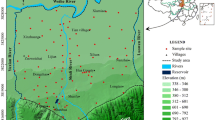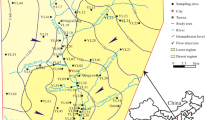Abstract
Nitrogen pollution of groundwater is becoming more and more serious due to intense and extensive industrial and agricultural activities. This may exert great influence on human health. In this paper, human health risk due to groundwater nitrogen pollution in Jinghui canal irrigation area in Shaanxi Province of China where agricultural activities are intense was assessed. Forty-seven groundwater samples were collected from shallow wells and analyzed for physicochemical indices in the study area. Water samples were analyzed for pH, total dissolved solids (TDS), total hardness (TH), major ions (Na+, K+, Ca2+, Mg2+, HCO3−, CO32−, Cl− and SO42−), nitrate (NO3–N), nitrite (NO2–N) and ammonia nitrogen (NH4–N). General groundwater chemistry was described by statistical analysis and the Piper diagram. Water quality was quantified via comprehensive water quality index (CWQI), and human health risk was assessed considering the age and exposure pathways of the consumers. The results show that the shallow groundwater is slightly alkaline and groundwater types are HCO3·SO4·Cl–Mg and HCO3·SO4·Cl–Na. Rock weathering and evaporation are main natural processes regulating the groundwater chemistry. The CWQI indicates that groundwater in the study area is seriously polluted by TH, TDS, SO42−, Cl− and NO3−. Human health risk is high because of high concentrations of nitrate in drinking water. The results also show that children are at higher risk than adults. The health risk through dermal contact is much lower than that through drinking water intake and can be ignored.




Similar content being viewed by others
Explore related subjects
Discover the latest articles and news from researchers in related subjects, suggested using machine learning.References
Batayneh AT (2012) Toxic (aluminum, beryllium, boron, chromium and zinc) in groundwater: health risk assessment. Int J Environ Sci Technol 9(1):153–162. https://doi.org/10.1007/s13762-011-0009-3
Bempah CK, Ewusi A (2016) Heavy metals contamination and human health risk assessment around Obuasi gold mine in Ghana. Environ Monit Assess 188:261. https://doi.org/10.1007/s10661-016-5241-3
Bouzourra H, Bouhlila R, Elango L, Slama F, Ouslati N (2015) Characterization of mechanisms and processes of groundwater salinization in irrigated coastal area using statistics, GIS, and hydrogeochemical investigations. Environ Sci Pollut Res 22(4):2643–2660. https://doi.org/10.1007/s11356-014-3428-0
Bureau of Quality and Technical Supervision of China (1994) National standard of the People’s Republic of China: quality standard for groundwater, GB/T 14848-93. (in Chinese)
Chen J, Wu H, Qian H (2016) Groundwater nitrate contamination and associated health risk for the rural communities in an agricultural area of Ningxia, northwest China. Expo Health 8:349–359. https://doi.org/10.1007/s12403-016-0208-8
Gibbs RJ (1970) Mechanisms controlling world water chemistry. Science 170:1088–1090. https://doi.org/10.1126/science.170.3962.1088
Golekar RB, Patil SN, Baride MV (2013) Human health risk due to trace element contamination in groundwater from the Anjani and Jhiri river catchment area in northern Maharashtra, India. Earth Sci Res J 17(1):17–23
Guo H, Wang Y (2005) Geochemical characteristics of shallow groundwater in Datong basin, northwestern China. J Geochem Explor 87(3):109–120. https://doi.org/10.1016/j.gexplo.2005.08.002
Han C (2010) The distribution of three nitrogen distribution and origin analysis in groundwater of Jinghuiqu irrigation area. Master thesis, Chang’an University, Xi’an. (in Chinese)
Han B, He J, Chen H, Chen H, Shi J (2006) Primary study of health-based risk assessment of organic pollution in groundwater. Earth Sci Front 13(1):224–229 (in Chinese)
Hayashi T, Tokunaga T, Aichi M, Shimada J, Taniguchi M (2009) Effects of human activities and urbanization on groundwater environments: an example from the aquifer system of Tokyo and the surrounding area. Sci Total Environ 407(9):3165–3172. https://doi.org/10.1016/j.scitotenv.2008.07.012
Lei L, Liang D, Yu D, Chen Y, Song W, Li J (2015) Human health risk assessment of heavy metals in the irrigated area of Jinghui, Shaanxi, China, in terms of wheat flour consumption. Environ Monit Assess 187:647. https://doi.org/10.1007/s10661-015-4884-9
Li P, Qian H (2018a) Water resources research to support a sustainable China. Int J Water Resour Dev 34(3):327–336. https://doi.org/10.1080/07900627.2018.1452723
Li P, Qian H (2018b) Water in loess. In: Meyers RA (ed) Encyclopedia of sustainability science and technology. Springer, New York, pp 1–17. https://doi.org/10.1007/978-1-4939-2493-6_968-1
Li P, Qian H, Wu J, Ding J (2010) Geochemical modeling of groundwater in southern plain area of Pengyang County, Ningxia, China. Water Sci Eng 3(3):282–291. https://doi.org/10.3882/j.issn.1674-2370.2010.03.004
Li P, Wu J, Qian H (2012) Groundwater quality assessment based on rough sets attribute reduction and TOPSIS method in a semi-arid area, China. Environ Monit Assess 184(8):4841–4854. https://doi.org/10.1007/s10661-011-2306-1
Li P, Qian H, Wu J, Zhang Y, Zhang H (2013) Major ion chemistry of shallow groundwater in the Dongsheng Coalfield, Ordos Basin, China. Mine Water Environ 32(3):195–206. https://doi.org/10.1007/s10230-013-0234-8
Li P, Qian H, Wu J, Chen J, Zhang Y, Zhang H (2014a) Occurrence and hydrogeochemistry of fluoride in shallow alluvial aquifer of Weihe River, China. Environ Earth Sci 71(7):3133–3145. https://doi.org/10.1007/s12665-013-2691-6
Li P, Wu J, Qian H, Lyu X, Liu H (2014b) Origin and assessment of groundwater pollution and associated health risk: a case study in an industrial park, northwest China. Environ Geochem Health 36(4):693–712. https://doi.org/10.1007/s10653-013-9590-3
Li P, Wu J, Qian H (2014c) Hydrogeochemistry and quality assessment of shallow groundwater in the southern part of the Yellow River alluvial plain (Zhongwei Section), China. Earth Sci Res J 18(1):27–38. https://doi.org/10.15446/esrj.v18n1.34048
Li P, Qian H, Howard KWF, Wu J (2015) Building a new and sustainable “silk road economic belt”. Environ Earth Sci 74(10):7267–7270. https://doi.org/10.1007/s12665-015-4739-2
Li P, Li X, Meng X, Li M, Zhang Y (2016a) Appraising groundwater quality and health risks from contamination in a semiarid region of northwest China. Expo Health 8(3):361–379. https://doi.org/10.1007/s12403-016-0205-y
Li P, Wu J, Qian H, Zhang Y, Yang N, Jing L, Yu P (2016b) Hydrogeochemical characterization of groundwater in and around a wastewater irrigated forest in the southeastern edge of the Tengger Desert, northwest China. Expo Health 8(3):331–348. https://doi.org/10.1007/s12403-016-0193-y
Li P, Zhang Y, Yang N, Jing L, Yu P (2016c) Major ion chemistry and quality assessment of groundwater in and around a mountainous tourist town of China. Expo Health 8(2):239–252. https://doi.org/10.1007/s12403-016-0198-6
Li P, Wu J, Qian H (2016d) Hydrochemical appraisal of groundwater quality for drinking and irrigation purposes and the major influencing factors: a case study in and around Hua County, China. Arab J Geosci 9(1):15. https://doi.org/10.1007/s12517-015-2059-1
Li P, Qian H, Zhou W (2017a) Finding harmony between the environment and humanity: an introduction to the thematic issue of the silk road. Environ Earth Sci 76(3):105. https://doi.org/10.1007/s12665-017-6428-9
Li P, Feng W, Xue C, Tian R, Wang S (2017b) Spatiotemporal variability of contaminants in lake water and their risks to human health: a case study of the Shahu Lake tourist area, northwest China. Expo Health 9(3):213–225. https://doi.org/10.1007/s12403-016-0237-3
Li P, Tian R, Xue C, Wu J (2017c) Progress, opportunities and key fields for groundwater quality research under the impacts of human activities in China with a special focus on western China. Environ Sci Pollut Res 24(15):13224–13234. https://doi.org/10.1007/s11356-017-8753-7
Li P, He S, He X, Tian R (2017d) Seasonal hydrochemical characterization and groundwater quality delineation based on matter element extension analysis in a paper wastewater irrigation area, northwest China. Expo Health. https://doi.org/10.1007/s12403-17-0258-6
Li P, Qian H, Wu J (2018a) Conjunctive use of groundwater-surface water to reduce soil salinization in the Yinchuan Plain, northwest China. Int J Water Resour Dev 34(3):337–353. https://doi.org/10.1080/07900627.2018.1443059
Li P, Wu J, Tian R, He S, He X, Xue C, Zhang K (2018b) Geochemistry, hydraulic connectivity and quality appraisal of multilayered groundwater in the Hongdunzi coal mine, Northwest China. Mine Water Environ. https://doi.org/10.1007/s10230-017-0507-8
Li P, Tian R, Liu R (2018c) Solute Geochemistry and Multivariate Analysis of Water Quality in the Guohua Phosphorite Mine, Guizhou Province, China. Expo Health. https://doi.org/10.1007/s12403-018-0277-y
Liu Y, Zhu H (2011) Characteristics of inferior variation of water environment and regulating capacity of groundwater reservoir in Jinghui canal irrigation district of China. Trans Chin Soc Agric Eng 27(6):19–24 (in Chinese)
Luo K, Zhang S, Tian Y, Gao X (2014) Arsenic distribution pattern in different sources of drinking water and their geological background in Guanzhong basin, Shaanxi, China. Acta Geol Sin (English Edition) 88(3):984–994. https://doi.org/10.1111/1755-6724.12251
Majumdar D (2003) The blue baby syndrome: nitrate poisoning in humans. Resonance 8(10):20–30. https://doi.org/10.1007/BF02840703
Ministry of Environmental Protection of the P.R. China (2014) Technical guidelines for risk assessment of contaminated sites (HJ 25.3–2014). China Environmental Science Press, Beijing (in Chinese)
Piper AM (1944) A graphic procedure in the geochemical interpretation of water-analyses. Trans Am Geophys Union 25(6):914–928. https://doi.org/10.1029/TR025i006p00914
Qian H, Li P (2011) Hydrochemical characteristics of groundwater in Yinchuan plain and their control factors. Asian J Chem 23(7):2927–2938
Qian H, Li P, Howard KWF, Yang C, Zhang X (2012) Assessment of groundwater vulnerability in the Yinchuan Plain, northwest China using OREADIC. Environ Monit Assess 184:3613–3628. https://doi.org/10.1007/s10661-011-2211-7
Rasmussen P (1996) Monitoring shallow groundwater quality in agricultural watersheds in Denmark. Environ Geol 27(4):309–319. https://doi.org/10.1007/BF00766700
Shi H, Shao M (2000) Soil and water loss from the Loess Plateau in China. J Arid Environ 45(1):9–20. https://doi.org/10.1006/jare.1999.0618
Su RQ (1996) Rational utilization of water resources in Loess Plateau region. Nat Resour Dly 11(1):15–22 (in Chinese)
Tao W, Zhang J, Wang J (2015) Case analysis and prediction of the groundwater level in Jinghuiqu irrigation district. J Geosci Environ Prot 3(2):85–89. https://doi.org/10.4236/gep.2015.32014
Wei J (2009) Groundwater hydro-chemical characteristics analysis and prediction study on the Jinghui irrigation area. Master thesis of Chang’an University, Xi’an, 69 pp. (in Chinese)
WHO (2011) Guidelines for drinking water quality, 4th edn. World Health Organization, Geneva
Wongsasuluk P, Chotpantarat S, Siriwong W, Robson M (2014) Heavy metal contamination and human health risk assessment in drinking water from shallow groundwater wells in an agricultural area in Ubon Ratchathani province, Thailand. Environ Geochem Health 36(1):169–182. https://doi.org/10.1007/s10653-013-9537-8
Wu J, Sun Z (2016) Evaluation of shallow groundwater contamination and associated human health risk in an alluvial plain impacted by agricultural and industrial activities, mid-west China. Expo Health 8(3):311–329. https://doi.org/10.1007/s12403-015-0170-x
Wu J, Li P, Qian H, Duan Z, Zhang X (2014) Using correlation and multivariate statistical analysis to identify hydrogeochemical processes affecting the major ion chemistry of waters: case study in Laoheba phosphorite mine in Sichuan, China. Arab J Geosci 7(10):3973–3982. https://doi.org/10.1007/s12517-013-1057-4
Wu J, Li P, Qian H (2015) Hydrochemical characterization of drinking groundwater with special reference to fluoride in an arid area of China and the control of aquifer leakage on its concentrations. Environ Earth Sci 73(12):8575–8588. https://doi.org/10.1007/s12665-015-4018-2
Wu J, Wang L, Wang S, Tian R, Xue C, Feng W, Li Y (2017) Spatiotemporal variation of groundwater quality in an arid area experiencing long-term paper wastewater irrigation, northwest China. Environ Earth Sci 76(13):460. https://doi.org/10.1007/s12665-017-6787-2
Xu Q, Zhang M (2017) Source identification and exchangeability of heavy metals accumulated in vegetable soils in the coastal plain of eastern Zhejiang province, China. Ecotoxicol Environ Saf 142:410–416. https://doi.org/10.1016/j.ecoenv.2017.03.035
Zhou L (2011) Study on the land use and safety evaluation of irrigated area: a case of Jinghuiqu irrigation district of Shaanxi Province. Ph.D. thesis of Chang’an Univeristy, Xi’an, 126 pp. (in Chinese)
Acknowledgements
We are grateful to the financial support from the National Natural Science Foundation of China (41502234, 41761144059 and 41602238), the Research Funds for Young Stars in Science and Technology of Shaanxi Province (2016KJXX-29), the General Financial Grant from the China Postdoctoral Science Foundation (2016M590911), the Fok Ying Tong Education Foundation (161098), the Special Financial Grant from the China Postdoctoral Science Foundation (2017T100719), the Special Financial Grant from the Shaanxi Postdoctoral Science Foundation (2016BSHTDZZ03), and the Program of Introducing Talents of Discipline to Universities (B08039). Anonymous reviewers and the Editor are sincerely thanked for their constructive comments on the earlier versions of this article.
Author information
Authors and Affiliations
Corresponding author
Additional information
This article is a part of a Topical Collection in Environmental Earth Sciences on Water resources development and protection in loess areas of the world, edited by Drs. Peiyue Li and Hui Qian.
Rights and permissions
About this article
Cite this article
Zhang, Y., Wu, J. & Xu, B. Human health risk assessment of groundwater nitrogen pollution in Jinghui canal irrigation area of the loess region, northwest China. Environ Earth Sci 77, 273 (2018). https://doi.org/10.1007/s12665-018-7456-9
Received:
Accepted:
Published:
DOI: https://doi.org/10.1007/s12665-018-7456-9




